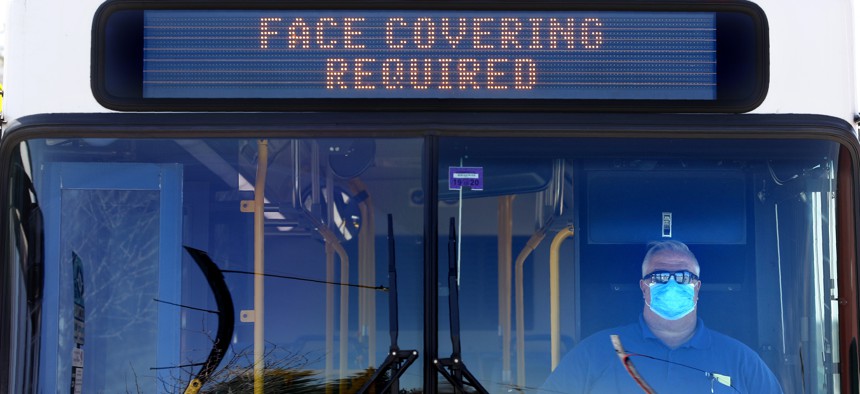Governments Offered Hazard Pay to Frontline Workers. Can They Keep It Up?

Metro Breez bus driver Rich Price, wearing a face mask, waits at a bus stop on May 13, 2020, in Portland, Maine. AP Photo/Robert F. Bukaty

Connecting state and local government leaders
With the virus surging across the country, it is unclear whether governments will again offer lump sum payments or keep paying out augmented salaries.
Frontline government employees, including police officers, sanitation workers, and bus drivers, had no option to work at home during the coronavirus pandemic—leading some city and state governments to offer hazard pay as compensation.
But as the pandemic drags on, so has its financial toll. And even as frontline workers continue to face the same dangerous conditions while the virus surges across the country, it is unclear whether local governments will have the money to sustain the extra pay.
Cities like Atlanta; Norfolk, Virginia; Birmingham, Alabama; and Flint, Michigan all approved hazard pay for at least some workers.
But the amount and the duration of the pay, as well as who is eligible to receive it, varies. Flint and Norfolk officials approved lump sum payments, while Atlanta signed off on $500 monthly payments for 5,400 frontline staff that lasted from June to September. Birmingham workers received a 5% pay bump for one month.
Residents in Portland, Maine voted last week to make the city the first in the country to require time-and-a-half pay for all employees, both private and public sector, who are required to report to work during a declared emergency.
In Norfolk, roughly 1,900 of about 5,000 city employees qualified for hazard pay under the city’s program, said Lori Crouth, the director of communications. Employees like firefighters, police officers, trash collectors and wastewater management workers received a one-time $2,000 bonus check over the summer.
While the pandemic continues, Crouth said the city has not discussed the possibility of another round of extra pay for frontline workers. Officials plan to brief the Norfolk City Council on the budgetary impact the Covid-19 pandemic has had on the city’s finances in coming weeks, she said. Any decisions on the future of hazard pay for city employees will be made by lawmakers after that.
But city, state, and county governments are facing tough budget outlooks in the coming year as tax collections plummeted during the pandemic. Some local governments are questioning whether they can continue to afford to provide hazard pay.
Montgomery County, Maryland paid out nearly $50 million in hazard pay as of the end of September, and payments are poised to top $72 million by the end of the year if they continue. Eligible employees are able to collect up to $800 every two weeks in hazard pay, significantly more than surrounding jurisdictions.
“What is your plan here? How do you envision the county paying for this?” asked councilmember Hans Riemer during a recent meeting with the county’s Chief Administrative Officer Richard Madaleno Jr. “It seems to me that this is a huge gamble that may end up as a major fiscal problem.”
There are plenty of reasons why local governments would want to offer hazard pay to employees, said Molly Kinder, a Rubenstein fellow at Brookings Institution’s Metropolitan Policy Program. When frontline workers are putting themselves at risk through prolonged contact with the public and facing burnout in stressful jobs, the extra pay may help with worker retention, she said.
“So many of these workers are low-wage workers, they are struggling to provide,” said Kinder, who authored a recent report on hazard pay. “Hazard pay is a very popular and effective way to ensure the workers who are sacrificing the most have the means to provide for their families.”
States have also created their own hazard pay funds, with some paying for wages in public sector-funded industries (like Virginia, which offered additional pay to home healthcare aides who served Medicaid patients) and others offering grants so that private companies can augment the wages of frontline workers like grocery store clerks and janitors.
Three states, Louisiana, Vermont and Pennsylvania, used CARES Act funding to finance hazard pay programs for a broad swath of private and public sector workers. But it’s unclear whether state and local governments will receive any additional coronavirus stimulus aid anytime soon from the federal government as the Trump administration has been unable to reach agreement on a proposal with congressional Republicans and Democrats.
Without additional federal assistance, it is unlikely that many state and local governments will be able to afford additional spending on hazard pay, Kinder said.
“Without some serious federal relief, city and local governments are going to face a lot of budgetary pressure,” she said. “If there is funding available, there will certainly be more interest in hazard pay.”
Editor's note: This story was updated after publication to add information about Montgomery County's hazard pay.
Andrea Noble is a staff correspondent at Route Fifty.

NEXT STORY: The Big Success Story of the Election Is the One You Didn’t Hear




